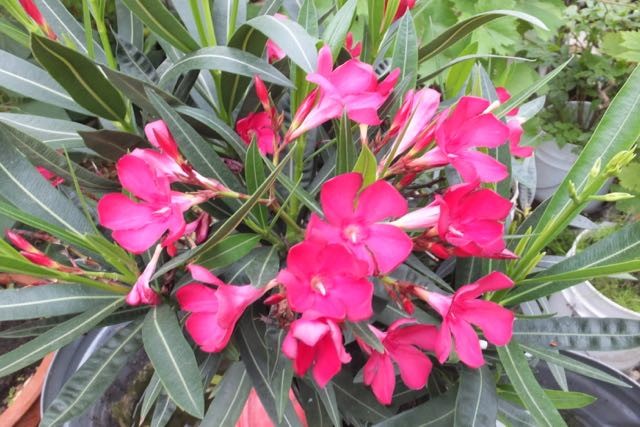
A classic greenhouse and conservatory flowering shrub Nerium oleander has adorned gardens in its native Mediterranean since Classical times. First noted as ‘introduced’ here in the sixteenth century Neriums became popular in early glasshouses for their very long flowering period. More so when they found Oleanders will force out of season. Thus Neriums soon became invaluable for almost year round blooms for display or cutting in reds, pinks and whites, and with a delicate perfume. These are borne on long straight stems springing from amongst long evergreen leaves of what looks much like an olive.
A member of the Apocyanaceae, Periwinkle, family other Nerium species are tropical. Because Oleanders borderline then in the warmest areas they have been grown in tubs moved out for summer. However they prefer a bit more warmth and flower better in a cool frost free greenhouse.
One of the easier tender plants to grow from cuttings you might be foolish to grow from seed as over sixty improved varieties are now available and not expensively. Oleanders are happy in a rich soil or compost, do fairly well cramped, but much better given larger tubs as they grow.
Their name Nerium comes from the Greek neros or humid indicating their original habitat, ie moist often being found near water, in dry conditions they flower less freely. So keep them warm and regularly watered, and add high nitrogen, high potash feed such as for roses. In winter their compost must be only just moist, in spring increase feed and water as growth quickens then reduce again in late autumn.
Not especially prone to pests or diseases Oleanders the one to watch for is red spider mite especially in hot dry conditions. Oleanders would love to be sprinkled- but most of the time that would spoil their flowers which are almost always showing. Standing the plants above a tray of wet pebbles is one solution though not actually necessary.
One task you need do is removing spent blooms as these do not fall off easily, pick daily to keep your display looking good.
It is sensible to wear gloves when handling Oleanders as their milky sap is extremely nasty (their tropical relatives are used for poison arrows). And please, please do not use those long straight stems for barbecue skewers as some unfortunate folk foolishly once did!


